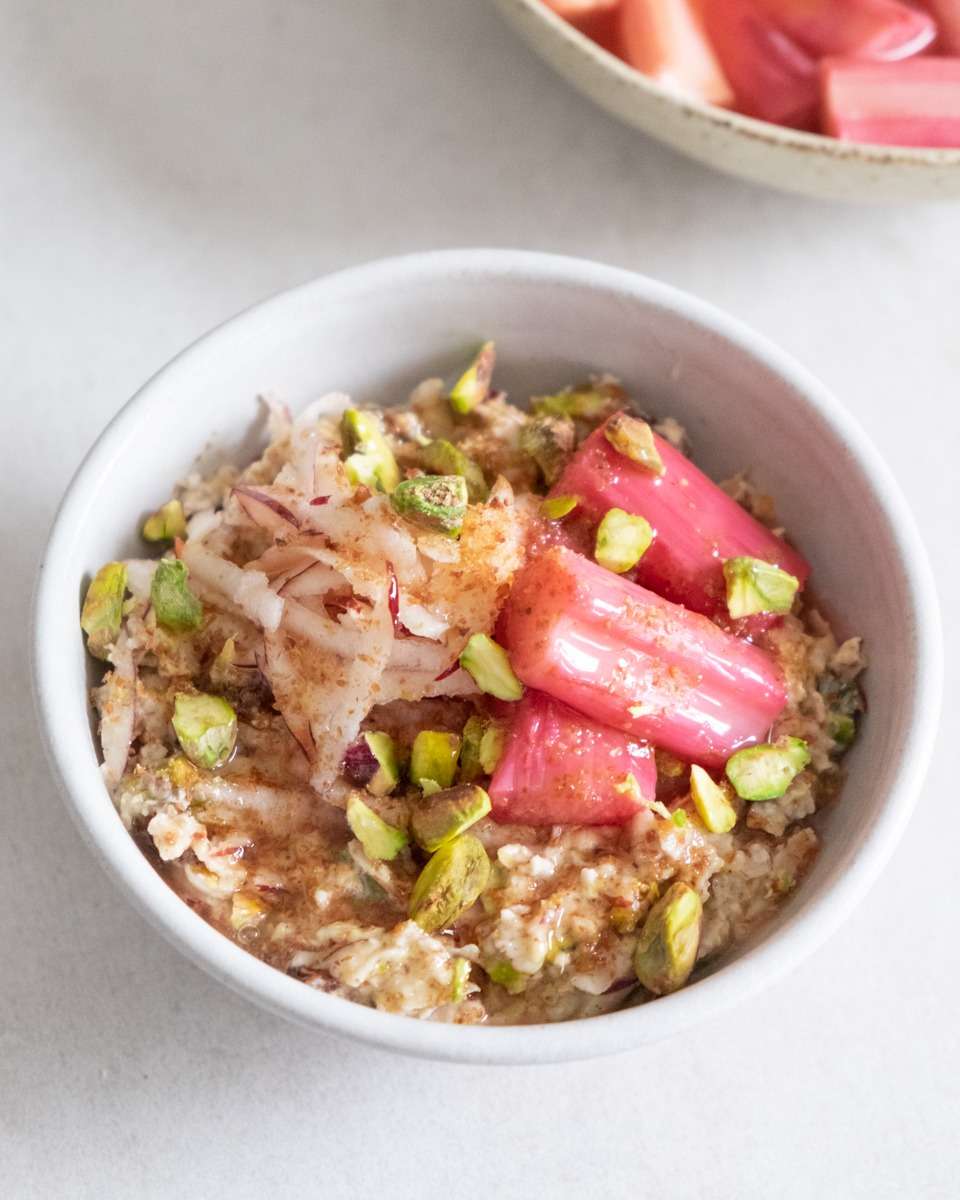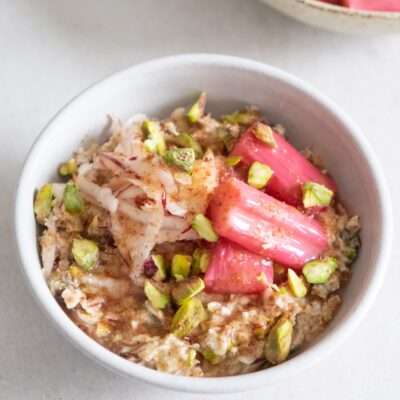Bircher Müsli

Still today it is known as a power food, packed with vitamins, fibre and protein. I like to serve mine with some seasonal fruit, poached on the weekend to last for the entire week. You can do this without adding any refined sugar. Instead, use some good-quality local honey to sweeten.
Ingredients
Müsli
serves 2
-
60g porridge oats
-
1 tbsp flax seeds (10 g)
-
1/4 tsp cinnamon
-
150 ml oat milk
-
1 large apple
-
30g organic sultanas (2 small handful)
-
30g roasted nuts (2 small handful)
-
1 clementine
-
seasonal fruit of your choice (see poached rhubarb below)
-
2 tsp raw honey
Poached Rhubarb (if not in season, change for seasonal fruit of choice)
serves 10
-
400g rhubarb, cut into 5 cm chunks.
-
2 unwaxed organic oranges
-
10g thyme sprigs
-
2 star anise
-
1 1/2 tbsp raw honey
Method
You can poach the rhubarb/fruit of choice for the entire week ahead. To do this, pre-heat the oven to 160°C. Top and tail the rhubarb, cut it into 5 cm chunks and add it to a baking dish along with the strips of orange zest, orange juice, thyme and star anise. Cover with kitchen foil and poach for 45 minutes, until you can easily pierce the rhubarb with a knife. Let it cool entirely, then remove the orange zest, thyme and star anise. Carefully transfer the rhubarb to a deep bowl. Drizzle the honey into the baking dish and mix it into the juices until dissolved. It’s important that the juices are at room temperature at this point, so none of the health properties of the honey get destroyed. Once dissolved, drizzle the juices over the rhubarb and leave to marinate in the fridge until needed. I like to add some roasted nuts to the Müsli, so you could also roast them at this point. For the pistachios, just 5 minutes at 180°C will make all the difference. Roast larger nuts for 10 minutes or until golden.
Start the Müsli the day before. Simply mix together the oats, flax seeds, cinnamon and oat milk and refrigerate overnight. You can multiply this recipe and do it for a couple of days in advance, but not more as the oat milk might go off.
The next day, core the apple and grate it into the bowl. Keep some aside for later to garnish (you can drizzle it with a bit of the clementine juice to stop it from browning). Add the sultanas and nuts, then squeeze in the remaining clementine juice. If the Müsli is too thick, loosen it with a dash of oat milk or water. If it’s too thin, add some more oats or flex seeds. Add the poached fruit and a tablespoon of the poaching juices, followed by the remaining apple as well as a dusting of flex seeds. Then drizzle over the honey and serve.

Bircher Müsli
Ingredients
- 60 g porridge oats
- 1 tbsp flax seeds (10 g)
- 1/4 tsp cinnamon
- 150 ml oat milk
- 1 large apple
- 30 g organic sultanas (2 small handful)
- 30 g roasted nuts (2 small handful)
- 1 clementine
- seasonal fruit of your choice (see poached rhubarb below)
- 2tsp raw honey
Instructions
- You can poach the rhubarb/fruit of choice for the entire week ahead. To do this, pre-heat the oven to 160°C. Top and tail the rhubarb, cut it into 5 cm chunks and add it to a baking dish along with the strips of orange zest, orange juice, thyme and star anise. Cover with kitchen foil and poach for 45 minutes, until you can easily pierce the rhubarb with a knife. Let it cool entirely, then remove the orange zest, thyme and star anise. Carefully transfer the rhubarb to a deep bowl. Drizzle the honey into the baking dish and mix it into the juices until dissolved. It’s important that the juices are at room temperature at this point, so none of the health properties of the honey get destroyed. Once dissolved, drizzle the juices over the rhubarb and leave to marinate in the fridge until needed. I like to add some roasted nuts to the Müsli, so you could also roast them at this point. For the pistachios, just 5 minutes at 180°C will make all the difference. Roast larger nuts for 10 minutes or until golden.
- Start the Müsli the day before. Simply mix together the oats, flex seeds, cinnamon and oat milk and refrigerate overnight. You can multiply this recipe and do it for a couple of days in advance, but not more as the oat milk might go off.
- The next day, core the apple and grate it into the bowl. Keep some aside for later to garnish (you can drizzle it with a bit of the clementine juice to stop it from browning). Add the sultanas and nuts, then squeeze in the remaining clementine juice. If the Müsli is too thick, loosen it with a dash of oat milk or water. If it’s too thin, add some more oats or flex seeds. Add the poached fruit and a tablespoon of the poaching juices, followed by the remaining apple as well as a dusting of flex seeds. Then drizzle over the honey and serve.
